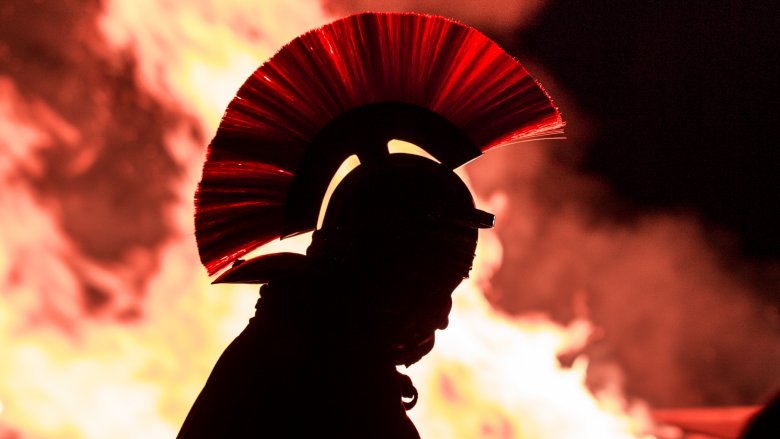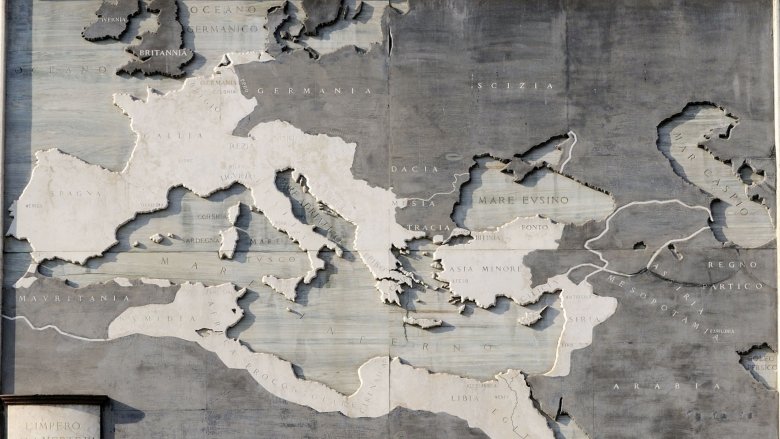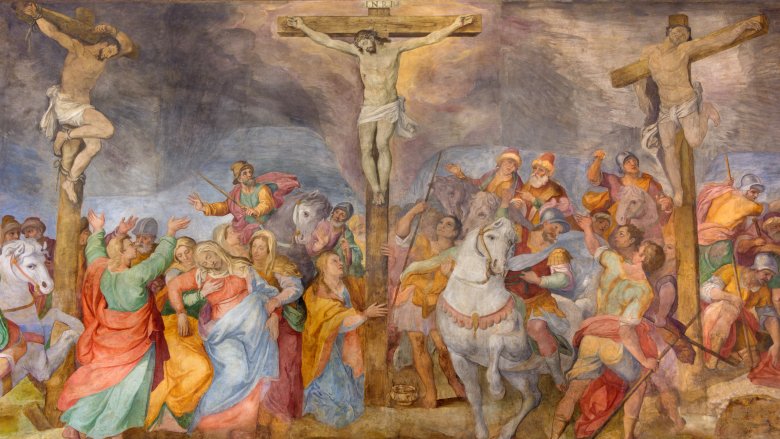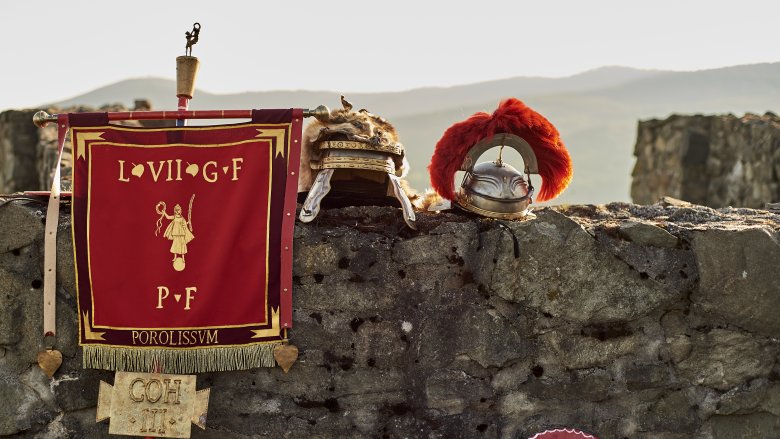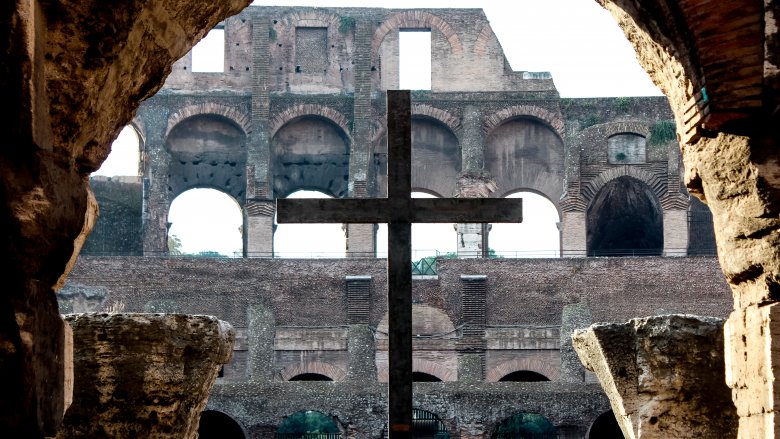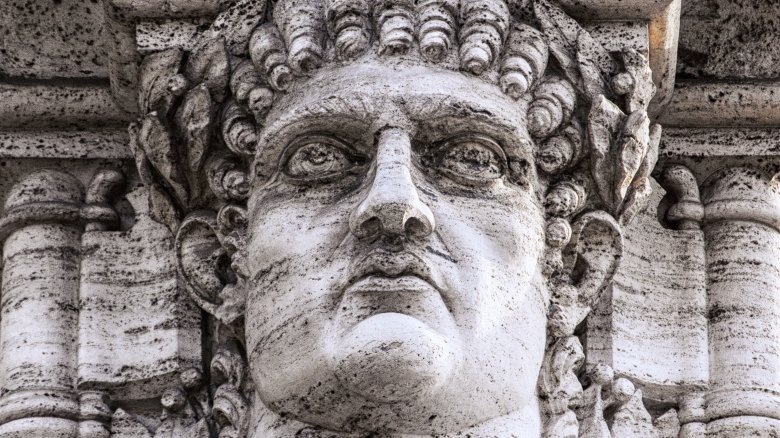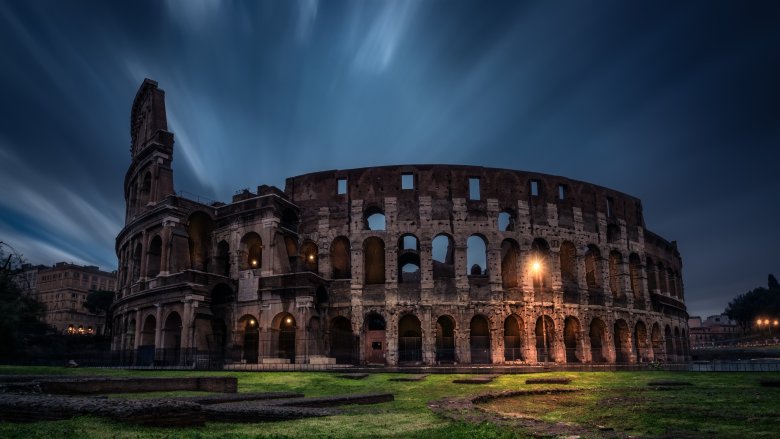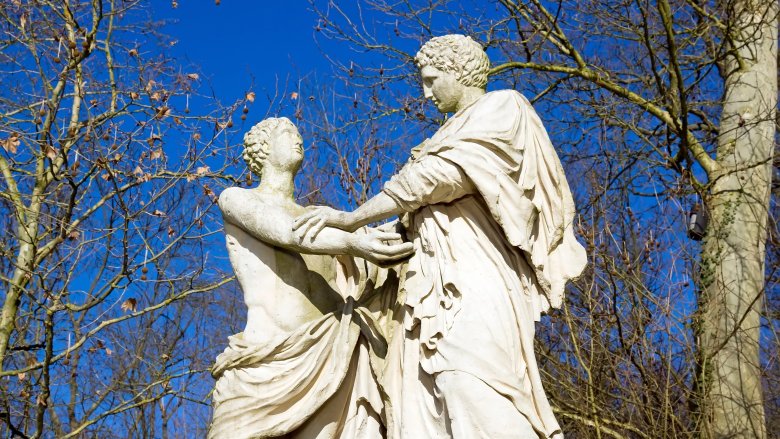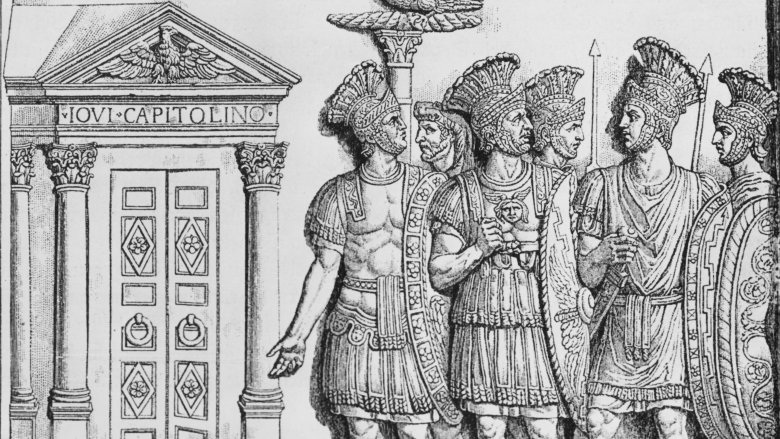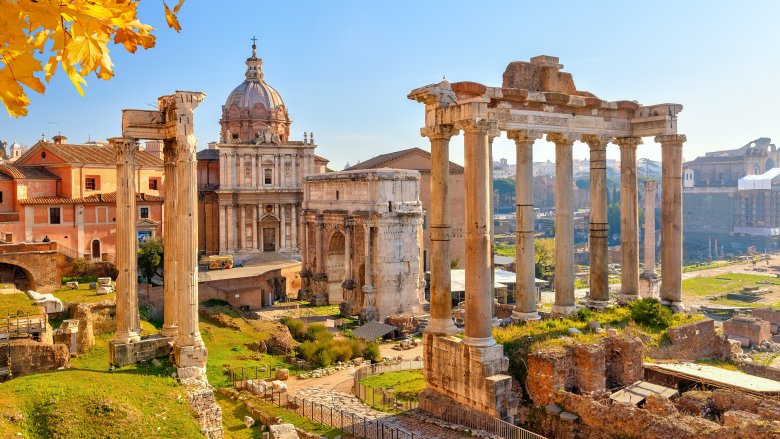Messed Up Things In The Roman Empire
For almost 1,500 years, the Roman Empire romped all over the political and military landscape of Europe, North Africa, and the Middle East. While the last thousand years of its existence may have been shouldered by the so-called Eastern Roman Empire (better known as the Byzantine Empire), Rome arguably peaked during the first few hundred years of the first millennium: post-Republic, pre-decline.
That was the time of coliseums, togas, and legionnaires. It was the time of slaves, masters, education, technology, and art. Vesuvius erupted, Britain was conquered, Nero's Rome burned, the Good Emperors ruled, and the gods flourished. Think of Rome, and you're probably thinking of this period. But an empire is as an empire does, of course, and these days were also characterized by brutality, oppression, conquest, and death. It shouldn't surprise you that some pretty horrific things happened under the rule of Rome — but it might surprise you just how horrific they actually were.
Paving the way for 2,000 years of imperialism
No empire can subsist on benevolence — that's one of history's most steadfast and awful truths. The simple fact is that basically every single one of the greatest civilizations to spread across the Earth, the Romans included, did so at the expense of the territories it conquered. Rome's method of conquest was what the World Heritage Encyclopedia describes as "raubwirtschaft." Otherwise known as a plunder economy, the aim of this form of colonialism is to control and acquire the resources of conquered territories for the benefit of the empire. Essentially you kill, you dominate, and then you steal everything that isn't nailed down — and that's where all your country's money comes from.
This means Rome's territories received little to no support from the Empire itself but were near constantly stolen from for the good of their rulers. And while Rome certainly wasn't the last civilization to employ this technique (as the African continent would discover during the 19th century), it was arguably one of the first.
Perfecting the art of crucifixion
Thanks to this little thing called Christianity, the practice of crucifixion is today one of the world's most notorious forms of execution. According to the classicist Louise Cilliers, crucifixion was considered "one of the most brutal and shameful modes of death" in the ancient world. While the Romans didn't quite invent the method (that honor goes to the Assyrians and Babylonians), they nonetheless took it upon themselves to spend 500 years perfecting it.
Roman citizens were exempt from the punishment, but anyone else — be they slaves, Christians, or foreigners — could be nailed up on a cross and left to die. The victim's death would come usually as a combination of blood loss, slow asphyxia, and oxygen deficiency in the blood. Because Roman guards were only permitted to leave the site of execution after the victim died, however, they'd often speed up the process by stabbing, beating, or burning them before the cross could do its job. So yeah: "perfected."
Decimation: military history's cruelest punishment
Decimation was a vicious and bizarre punishment concocted by the legions of Rome to punish units which mutinied, fled during battle or under-performed at times of war. The word literally means "removal of a tenth," and from that you can probably gather what went down. It would go like this: The offending group of soldiers would be divided into sections of 10 men. A lottery would then take place, in which one of those men would be chosen by random. The other nine would then beat that man to death, regardless of his rank, reputation, or even the part he played in whatever went down in the first place. The rest of the soldiers would then be forced to make camp far away from the full army, having to subsist for days on a diet of raw barley.
Because of its effect on morale, decimation was rarely implemented as a punishment, but it wasn't unheard of. Most egregious of all was an instance in the third century during which Emperor Maximian ordered the decimation of the Theban Legion for refusing to renounce their Christianity. After the decimation had been carried out, they again refused their orders — and were decimated again. Eventually, the entire legion was wiped out by Maximian for their dissent.
The annihilation of an entire religion
Religious persecution was nothing new to the world by the time of the Roman Empire — conquerors had been attempting to destroy religions for eons before the Romans, and they haven't stopped in the intervening millennia. Rarely, however, does a civilization actually succeed in purging a religion from their territory.
Enter the Roman Empire. In 57 A.D., the conquest of Britain was in full swing, but Rome's armies were still struggling to fight back against a guerrilla campaign waged by the Welsh tribes in the country's western regions. Frustrated by his defeats, the Roman general Suetonius Paulinus took his legions from the Roman city of Chester to the island of Mona (today known as Anglesey). Mona was the spiritual home of the Britannic druidic religion and the literal home of the religion's leaders and native people. According to writer and broadcaster Phil Carradice, "many, if not most, of the druids actually lived there and were certainly on the island when Suetonius attacked."
A massacre followed. Men, women, and children were murdered and their bodies burned on makeshift pyres. The druids' sacred groves were burned, their altars smashed and their temples sacked. In one swift blow, Suetonius had sounded the death knell for Welsh resistance and deprived an entire culture of its religious spirit. The few survivors fled to Ireland, and the Druidic religion was driven underground. It has never recovered.
Relentless persecution of Christians
It may not surprise you to learn that Rome's attempts to destroy another religion — Christianity — weren't quite as successful as their efforts against druidism, but you can be assured they gave it a go. Nero was the first Roman leader to begin persecuting Christians, having blamed them for the Great Fire of Rome in 64 A.D. to deflect rumors that he himself had been responsible for the blaze. According to Tacitus, he would have Christians dressed in beast skins and torn apart by dogs. Under Trajan in the second century A.D., Christians existed under a "don't ask, don't tell" policy enacted by Rome. That, of course, didn't stop other Roman citizens taking matters into their own hands, and Christians often found themselves victims of mob violence.
Christians who admitted to their religion freely and refused to repent could receive any number of punishments. Some were executed by beheading, while others were crucified, burned, or condemned to the beasts — and it's from here that the popular image of Christians being fed to the lions in the arena originates.
The madness of Rome's emperors
Hundreds of emperors clambered to power during the reign of the Roman Empire. Many were legitimate; others, not so much. Some were powerful; some were practically benign. And some were wise, just, and good — or as good as an emperor can be — eschewing malice, cruelty and insanity.
There are almost too many examples to list. Among the most significant is Caracalla, who, after hearing that the people of Alexandria were mocking him, rode to that city and began a period of festivities to lure in citizens from the surrounding countryside. He then gathered all the young men in a nearby field, telling them they would form a new honorary phalanx in his army. Unarmed, most of them were cut down by Caracalla's soldiers — the rest were buried alive.
You've also got Commodus, of course, who believed he was the literal reincarnation of Hercules, and frequently entered the arena to fight animals or other gladiators (usually handicapped ones). He also had a penchant for murdering senators and tried to rename Rome after himself.
And who could forget Caligula? He's the guy who committed incest with his own sister, watched executions as a hobby, and once decreed to his citizenry that he was a living god and that a bridge should be built from the Temple of Jupiter to his palace so he could check in with his fellow deity. Rome had some real characters.
Arenas bathed in blood and water
The arena is one of the most iconic facets of Roman life, and rightly so — it was a vital part of the empire's cultural identity and a helpful tool of the emperors to placate and satisfy their citizens. And not all arena events were violent, but plenty of them were bloody as all get out. Chief among these were the gladiatorial games.
Anyone could be a gladiator. They were usually slaves or prisoners of war, though free-born volunteers occasionally took part to qualify for the payment that gladiators received upon taking their oath. Some emperors, however, forced upper-class Roman citizens to fight in the arena, too. The games themselves could range in scale from bouts between individual gladiators to recreations of entire battles — on both land and sea — which might feature thousands of participants, chariots, horses, or ships at any time.
Aside from all this, arenas also formed the backdrop for the killing of exotic animals, martyrdoms, the execution of prisoners, and other such atrocities. Par for the course, right?
Sexual depravities, misogyny and rape culture
The Roman perspective on sexuality was, in many ways, nothing short of monstrous. Orientation took a backseat to the notion of dominance. According to historian Matthew Rueger, "it was socially acceptable for a strong Roman male to have intercourse with men or women alike, provided he was the aggressor." Men were expected to sleep with slaves, visit prostitutes, and even commit rape, so long as the victims were of a lower social status.
The Romans also believed pedophilia to be a natural expression of male domination, and relationships between men and young boys were accepted and even idealized. Rueger writes that a sexual relationship with another male, even if they were a child, "represented a higher form of intellectual love and engagement." Women, meanwhile, were seen as physically and mentally weak: inferior to men in every way and good only to serve. Women were often married young, were judged on their ability to bear children, and could be punished severely if they committed offenses like adultery.
The machinations of the Praetorian Guard
Rarely in a society governed by dictatorship is power taken away from the dictator and given back to the people. Often, power might be transferred from the dictator to another dictator. In the later days of Rome, however, the reins of the Empire were actually handed over to the dictator's bodyguards.
The Praetorians had been founded in the days of the Roman Republic as an escort provided to high-ranking soldiers and politicians. Augustus, the first emperor, established a newer, larger unit, known as the Praetorian Guard: a permanent bodyguard of 4,500 men whose sole purpose was to protect the emperor and his family. By the later stages of the empire, this unit consisted of over 10,000 men. Members of the Praetorian Guard were exempt from taxes, given better equipment, received higher pay, and were often given gifts by the emperors they protected.
As the strength of the throne waned, the Praetorians began to wield more and more political power. Emperors were forced to appease them with gifts to consolidate control. They murdered Pertinax in 193 A.D. for not paying them enough, then offered the throne to anybody who could afford it. Emperor Caracalla even ended up murdered by a Praetorian officer named Macrinus — who was then proclaimed emperor himself. Few in Rome commanded as much strength as the Praetorian Guard, and thanks to their efforts the empire was ruled for vast periods of time by what was little more than a military junta.
A violent end
The fall of Rome was rapid, violent, and cataclysmic. The plunder economy was unsustainable — once the empire's conquests ceased and invaders from beyond their borders began to pick off colonies, Rome's finances shrank and the state was plunged into economic depression. Meanwhile, in-fighting between aspiring emperors and various political players began to tear the empire apart from within. Finally, aggressive migration into Rome's territories (which was, according to the BBC, "carried forward at the point of the sword") caused a total collapse of the state by practically destroying the empire's tax base.
Many imperial regions fell to pieces entirely. Britain and northern Gaul, in particular, took the brunt of the empire's destruction, as population numbers dropped, especially among peasants. Across Europe, military power shifted into the hands of the elite landowners who had the means to make the most of the chaos. The Pax Romana was now nothing more than a distant memory; as before, war was the method by which the wealthy could secure power. And from this charred, barren landscape sprang the warlords, the aristocrats, and the successor kings: the new breed of rulers who would dominate Europe for another thousand years.
